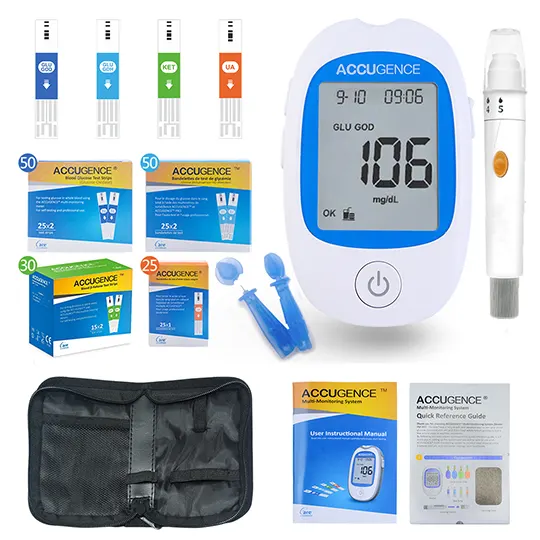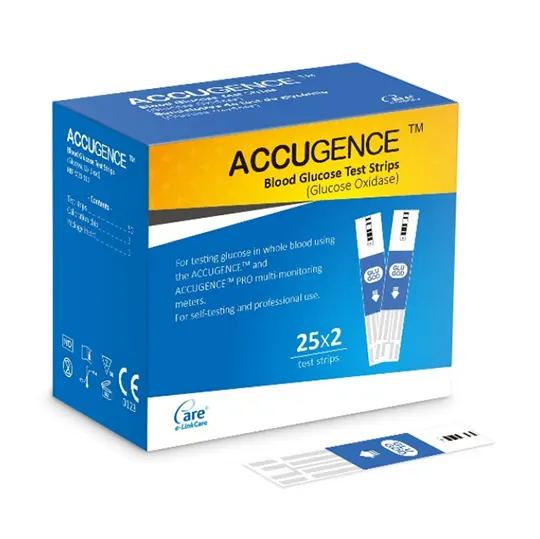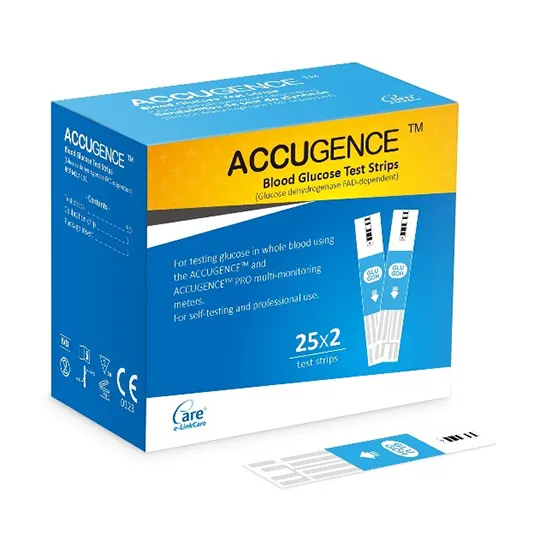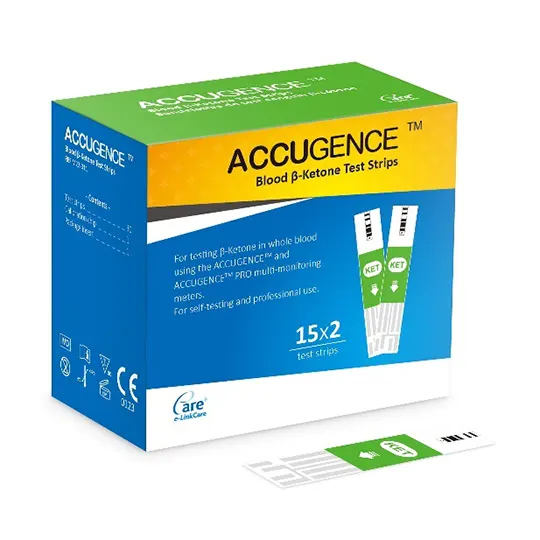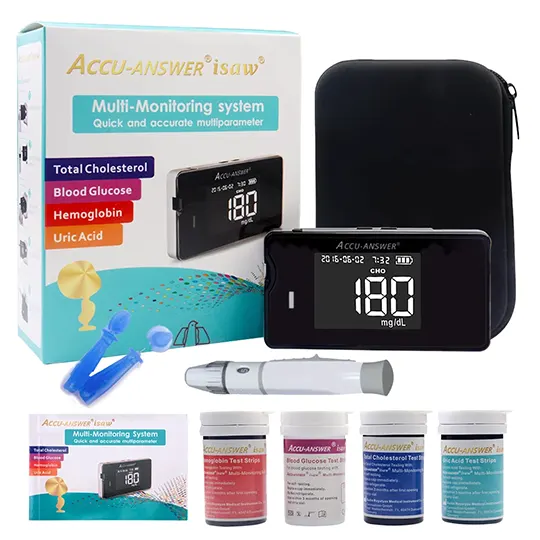Blood Glucose, β-Ketone and Uric Acid 4 in1 at Home Multi-Monitor System
SKU: 14-0002_en
$99.00 $160.00
Delivery: free (1-2 business weeks)
Product Description
Keep track of your blood Glucose (glucose oxidase (GOD) and glucose dehydrogenase (GDH)), β-Ketone and Uric Acid levels easily with our 4 in1 Multi-Monitoring System (model: PM 900). Our state-of-the-art meter makes it easier for you to stay up-to-date with your diabetes, ketonemia and gout, getting your readings quickly with just a 0.7-1 µL blood sample and results in as fast as 5 to 15 seconds. Just insert the test strip and compare the strip type and code number on the meter display with the strip vial label which tested, and make sure that they are matched.
The kit comes with everything you need, including our 5-depth lancing device and lancets, which make blood sample collection painless and hassle-free. Adjustments: 0 – 1 for soft or delicate skin, 2 – 3 for normal skin, 4 – 5 for thick or callused skin.
Whether at home or on-the-go, the included carrying bag will ensure that everything is organized and that you always have everything you need.
Reference ranges:
- β-Ketone: < 0.6 mmol/L
- Uric Acid:
- Female 1.5–5.95 mg/dL
- Male 2.5–6.9 mg/dL
- Glucose 70–110 mg/dL
Tests results interpretation you can find here.
Suggested testing times and target goals you can find here.
4 in 1 Blood Testing Kit: 1x monitor meter, 1x lancing device, 50x lancets, 1x portable bag, 1x user manual, 100x glucose test strips (50pc GOD + 50pc GDH), 25x uric acid test strips, 30x β-ketone test strips.
The meter uses two CR2032 coin cell batteries (due to international transportation rules batteries not being included).
| Measure Range | Response Time | |
|---|---|---|
| Blood Uric Acid | 3–20 mg/dL | 15 Seconds |
| Blood Glucose (GOD) | 10–600 mg/dL | 5 Seconds |
| Blood Glucose (GDH) | 10–600 mg/dL | 5 Seconds |
| Blood β-Ketone | 0.0–8.0 mmol/L | 5 Seconds |
![]() The device should not be used for patients who are dehydrated, in shock, critically ill or in a hyperosmolar state!
The device should not be used for patients who are dehydrated, in shock, critically ill or in a hyperosmolar state!
Dimensions: 12х6х1.6 cm
Weight: 110 g
Color: black
Unit of measure: Uric Acid, Glucose - mg/dL, β-Ketone - mmol/L
Warranty: 1 year
Shelf life for test strips: Uric Acid, Glucose - 24 month, β-Ketone - 18 month
Customer Reviews
★★★★★ Love the machine, it's of great quality, quick results and comes with everything I need.
★★★★★ Came with everything you need. Very easy to read and understand manual. Also uses very miniscule amount of blood! Awesome! :)
★★★★★ The setup is simple to perform and testing is a breeze. It's a nice compact unit and the supplied case takes all of the accessories you need. Great instructions although a book format would be easier. I use the 5 setting on the needle applicator and it doesn't hurt at all. Great product!
★★★★★ Hi. Thank you for the monitor. I am 74 years old and found it quite easy to set up and was using it the same night as it was delivered. My old machine was getting a bit erratic with it's readings, but my new one is fine and easy to use giving fast readings which seem to be very accurate. From my use so far I would recommend it to anyone thinking of buying one.
★★★★★ So many products out there and hard to know as a newbie which to choose. Eventually after much researching I chose this one for ease of use, clear display and cost.I am not disappointed. Excellent value especially as you get 50 strips and lancets. Very easy to read and quick results.
★★★★★ I am on the borderline and ned to monitor my levels. This machine is easy to use and appears accurate to what I have been told my levels are this machine reads the the same. It's small and compact and easily fits in your handbag. I am very pleased with my purchase.
★★★★★ This test kit came with clear instructions and came with all you need in one package. Even the batteries! I've recently been diagnosed with Diabetes so getting peace of mind was very important from the start.This test kit provided just that. It's quick and simple.It's an excellent product. Thanks guys!
★★★★★ Having been advised I was borderline diabetic I need to carefully monitor my blood sugar levels. I bought the metene which is ideal and I find it very easy to use.In the past it was always possible to pop in to see the Nurse at my local surgery to have a test carried out but following the pandemic of course such appointments are not available.
★★★★★ A relative of mine was at my house and he had his tester with him so i got him to test me and was shocked to find my blood suger was high and he recommended this one so i purchased it. Very easy to use and spot on iv also purchased the blood pressure one off them also thanks.
Additional information about blood testing
Uric Acid
↑ High Uric Acid Level
- Gout, renal failure, leukemia, multiple myeloma, polycythemia, lymphoma, other disseminated neoplasms, toxemia of pregnancy, psoriasis, glycogenosis type I, Lesch-Nyhan syndrome, Down syndrome, polycystic kidney disease, and chronic lead nephropathy
- A purine-rich diet (liver, kidney, sweetbread), as well as severe exercise, increases uric acid values.
- In association with hyperlipidemia, obesity, hypertension, arteriosclerosis, diabetes mellitus, ethanol consumption, hypoparathyroidism, acromegaly, sarcoidosis, and liver disease; after gross tissue destruction (increased nucleoprotein breakdown), and in excessive nucleoprotein turnover (e.g., myeloid leukemia, pernicious anemia, and strychnine poisoning).
- Acute (sometimes dangerous) elevation follows treatment of leukemia with cytotoxic drugs.
↓ Low Uric Acid Level
- Wilson’s disease, Fanconi’s syndrome, some malignancies (e.g., Hodgkin’s disease, multiple myeloma, bronchogenic carcinoma), xanthinuria, SIADH, deficiencies of adenosine deaminase, purine, and nucleoside phosphorylase; low-purine diet.
Glucose
↑ High Glucose Level
- Primary: Diabetes mellitus (adult and juvenile)
- Physiological: Strenuous exercise, strong emotion, increased epinenphrine from injection, shock, burns; infection (?)
- Endocrine disorders: Pheochromocytoma, thyrotoxicosis, acromegaly, gigantism, Cushing’s syndrome, glucagonoma, somatostatinoma
- Pancreatic disease: Acute and chronic pancreatitis; pancreatitis resulting from mumps, cystic fibrosis, hemochromatosis; neoplasms of pancreas
- Related to other disorders: Cerebrovascular accident, acute myocardial infarction or severe angina, chronic liver disease, chronic renal disease
- Related to insulin receptor antibodies: Acanthosis nigricans
- Vitamin B1 deficiency: Wernicke’s encephalopathy
↓ Low Glucose Level
- Pancreatic disorders: Islet cell tumor, glucagon deficiency
- Tumors: Carcinoma of adrenal gland, carcinoma of stomach, fibrosarcoma
- Severe hepatic disorders: Poisoning (e.g., arsenic, carbon tetrachloride, chloroform, cinchophen, phosphorus, alcohol, salicylates, phenformin, antihistamines)
- Endocrine disorders: Hypopituitarism, Addison’s disease, hypothyroidism
- Functional disorders: Postgastrectomy, gastroenterostomy, autonomic nervous system disorders
- Pediatric anomalies: Prematurity, infant of diabetic mother, ketotic hypoglycemia, Zetterstrom’s syndrome, idiopathic leucine sensitivity
- Enzyme deficiency diseases: von Gierke’s syndrome, galactosemia, maple syrup urine disease, fructose intolerance
Hemoglobin (Hb), Total
↑ High Total Hemoglobin (Hb) Level
- Polycythemia, after vigorous exercise or excitement, hemoconcentration (as in dehydration, burns, severe vomiting, intestinal obstruction)
↓ Low Total Hemoglobin (Hb) Level
- Anemia, recumbency; drugs that cause aplastic anemia or that cause hemolysis, either in G6PD deficiency or by an immune mechanism
β-Ketone
β-Hydroxybutyrate (BOHB) (the predominant ketone) is a better indicator of clinical state than acetoacetate in diabetic ketoacidosis (DKA). The BOHB/AcAc ratio is normally 3:1. This ratio will increase to 6:1 or 12:1 during ketoacidosis, particularly if there is associated decreased tissue perfusion, metabolic acidosis, and tissue catabolism. All of these will favor reductive metabolism and hence BOHB production. Acetoacetate may increase during therapy for DKA because BOHB is oxidatively metabolized to acetoacetate.
↑ High β-Ketone Level
- Diabetic ketoacidosis, prolonged excessive insulin administration in diabetics, prolonged fasting (so-called ketotic hypoglycemia, most common in children aged 1-6 yr), severe carbohydrate restriction with normal fat intake (weight-reducing diets), anorexia nervosa, persistent vomiting, glycogen storage diseases I, III, and VI, branched-chain ketonuria, methylmalonic aciduria, exercise in untrained subjects,1 pregnancy,1 stress, postanesthesia.
Blood Glucose
Tracking your blood glucose concentration through frequent tests is an important part of proper diabetes care. Your healthcare professional will help you to decide the normal target range for your glucose levels. They will also help you to determine when and how often to test your blood glucose. Some suggested times are:
- When you wake up (fasting level)
- Before breakfast
- 1 - 2 hours after breakfast
- Before lunch
- 1 - 2 hours after lunch
- Before or after exercise
- Before dinner
- 1 - 2 hours after dinner
- Before bedtime
- After a snack
- At 2 or 3 AM, if taking insulin
You may need to test more often whenever1:
- You add or adjust your diabetes medication.
- You think your blood glucose levels may be too low or too high.
- You are ill, or feeling uncomfortable over long periods of time.
Expected blood glucose levels for people without diabetes 2:
| Time | Range, mg/dL | Range, mmol/L |
| Fasting and Before Meals | 70 - 100 | 3.9 - 5.6 |
| 2 Hours after Meals | Less than 140 | Less than 7.8 |
Talk to your healthcare professional to set your own daily target ranges.
| Time of Day | Your Target Range |
| Waking up (Fasting level) | |
| Before meals | |
| 2 hours after meals | |
| Bedtime | |
| 2 AM to 3 AM | |
| Other |
(Note: 1 mmol/L = 18 mg/dL)
Use the logbook to record your blood glucose measurements and related information. Bring the logbook with you when you visit your doctor so that you can determine how well your blood glucose is being controlled. This can help you and your healthcare professional make the best decisions about your glucose control plan.
β-Ketone
Continuous high blood glucose means your body does not have enough insulin to burn glucose, instead it will start burning fat and this produces a chemical called β-Ketone. If left untreated, β-Ketones continues to rise and can result a condition called Diabetic Ketoacidosis, or DKA. This condition may lead to death therefore requires immediate medical attention. It is suggested that if your blood glucose level is above 300 mg/dL or 16.7 mmol/L for two tests in a row, a β-Ketone test needs to be applied immediately.
There are situations when you have positive β-Ketones without blood glucose being too high. Positive β-Ketones are not a problem when blood glucose levels are within range and you are trying to lose weight.
The normal adult blood β-Ketone range for person without diabetes is less than 0.6 mmol/L. Consult with your healthcare professional for the blood β-Ketone range that is appropriate for you. If your blood β-Ketone test result is between 0.6-1.5 mmol/L and glucose is higher than 300 mg/dL, this may indicate development of a medical concern. You need to contact with your healthcare professional for assistance. If your blood β-β-Ketone test result is more than 1.5 mmol/L and glucose is higher than 300 mg/dL, contact with your healthcare professional immediately. This indicates a risk of developing diabetic ketoacidosis (DKA).
Uric Acid
It is important to monitor your Uric Acid level because high levels of uric acid in the blood can cause solid crystals to form within joints. This causes a painful condition called gout. If gout remains untreated, these uric acid crystals can build up in the joints and nearby tissues, forming hard lumpy deposits called tophi. High levels of uric acid may also cause kidney stones or kidney failure.
Most labs that carry out uric acid test will have slightly different definitions of low, Normal and high levels of uric acid in the blood. As such, the information here and all you come across online should be interpreted as a guide only. It will be the decision of your doctor as to whether or not your levels are in the safer regions.
| Men | 3.4 to 7.0 mg/dL | 202 to 416 µmol/L |
| Women | 2.4 to 6.0 mg/dL | 143 to 347 µmol/L |
| Children | 2.0 to 5.5 mg/dL | 119 to 327 µmol/L |
Reference:
- Jennifer Mayfield and Stephen Havas, “Self-Control: A Physician’s Guide to Blood Glucose Monitoring in the Management of Diabetes – An American Family Physician Monograph”
- ADA Standards of Medical Care in Diabetes, 2015. Diabetes Care, 2015, Vol.38, Supplement

